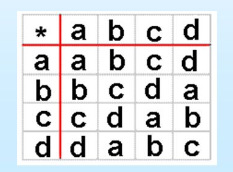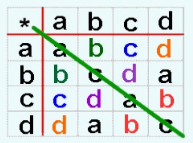Binary Operations
A binary operation is simply a rule for combining two objects of a given type, to obtain another object of that type. You first learned of binary operations in elementary school. The objects you were using were numbers and the binary operations you investigated were addition, subtraction, multiplication and division. As you will discover in this lesson, binary operations need not be applied only to numbers.
A binary operation on a finite set (a set with a limited number of elements) is often displayed in a table that demonstrates how the operation is performed.
 This table shows the operation * (“star”). The operation is working on the finite set A = { a, b, c, d }. The table shows the 16 possible calculations using the elements of set A.
This table shows the operation * (“star”). The operation is working on the finite set A = { a, b, c, d }. The table shows the 16 possible calculations using the elements of set A.
Reading the table: Read the first value from the left hand column and the second value from the top row. The answer is in the cell where the row and column intersect.
For example, a * b = b, b * b = c, c * d = b, d * b = a and so on.
What is the identity element for the operation * ?
(What single element will always return the original value?)
The identity element is a.
a * a = a, b * a = b, c * a = c, d * a = d
Checking for the Identity Element:
You will know the identity element when you see it, because all of the values in its row or column are the same as the row or column headings.
What is the inverse element for b ?
(What element, when paired with b, will return the identity element a?)
The inverse element of b is d.
b * d = a
Is the operation * commutative?
(Does the property x + y = y + x hold for ALL possible arrangements of values?)
Start testing values:
a * b = b * a is true since both sides equal b.
c * d = d * c is true since both sides equal b.
WOW! Having to test ALL possible arrangements could take forever! There must be an easier way………
Testing for Commutativity Shortcut:
It is easy to check whether an operation defined by a table is commutative. Simply draw a diagonal line from upper left to lower right, and see if the table is symmetric about this line.
 Since this table is symmetric about the diagonal (from upper left to lower right), the operation is commutative.
Since this table is symmetric about the diagonal (from upper left to lower right), the operation is commutative.
It would only have taken one instance of lack of commutativity for this answer to have been “no”.
True or False:
(a * b) * c = a * (b * c) ???
Perform the operations in the order indicated by the parentheses:
(a * b) * c = a * (b * c)
b * c = a * d
d = d
So, yes, this statement is true for this table.
This question deals with only one case of the associative property for this table. Unfortunately there is NO shortcut for checking associativity as there is for checking commutativity when working with a table.
If asked the general question “Does this operation possess the associative property?”, you would have to check ALL possible arrangements. On the other hand, if you find one instance where associativity fails, you are done and the answer is “NO”.
